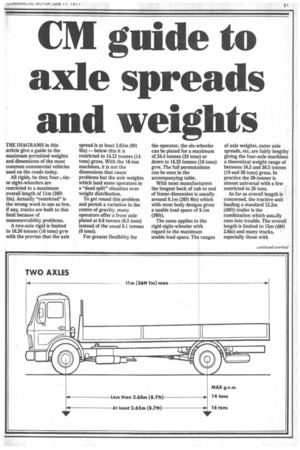CM guide to axle spreads and weights
Page 83

Page 85

If you've noticed an error in this article please click here to report it so we can fix it.
THE DIAGRAMS in this article give a guide to the maximum permitted weights and dimensions of the most common commercial vehicles used on the roads today.
All rigids, be they four-, sixor eight-wheelers are restricted to a maximum overall length of Ilrn (36ft urn). Actually "restricted" is the wrong word to use as few, if any, trucks are built to this limit because of manoeuvrability problems.
A two-axle rigid is limited to 16.26 tonnes (16 tons) gvw with the proviso that the axle spread is at least 2.65m (8ft 8in) — below this it is restricted to 14.22 tonnes (14 tons) gross. With the 16-ton machines, it is not the dimensions that cause problems but the axle weights which land some operators in a "dead split" situation over weight distribution.
To get round this problem and permit a variation in the centre of gravity, many operators offer a front axle plated at 6.6 tonnes (6.5 tons) Instead of the usual 6.1 tonnes (6 tons).
For greater flexibility for the operator, the six-wheeler can be plated for a maximum of 24.4 tonnes (24 tons) or down to 16.25 tonnes (16 tons) gvw. The full permutations can be seen in the accompanying table.
With most manufacturers the longest back of cab to end of frame dimension is usually around 8.1m (26ft 61n) which with most body designs gives a usable load space of 9.1m (30ft).
The same applies to the rigid eight-wheeler with regard to the maximum usable load space. The ranges of axle weights, outer axle spreads, etc, are fairly lengthy giving the four-axle machines a theoretical weight range of between 18.3 and 30.5 tonnes (18 and 30 tons) gross. In practice the 30-tonner is almost universal with a few restricted to 28 tons.
As far as overall length is concerned, the tractive unit hauling a standard 12.2m (40ft) trailer is the combination which usually runs into trouble. The overall length is limited to 15m (49ft 2.6in) and many trucks, especially those with sleeper-cabs, have great difficulty in squeezing in under this figure.
The proposed EEC figure for the future is 15.5m (50ft 10in), which will not provide much in the way of extra carrying capacity it is merely to allow for the variation in coupling with a variety of tractors and trailers.
To enable an artic/ trailer combination to run at the full 32 tons gew in the UK, the inner axle spread must be at least 4.2m (13ft 9in).
For operators whose main concern is maximum loading volume, then the drawbar outfit is the most logical. Although still limited to 32 tons gross, such a rigid/trailer combination can go up to 18m (59ft lin) in overall length. It is not possible to use a truck and trailer both built to their individual maximum lengths as they would total 23m (75ft 5in), but even so a useful 14.6m (48ft) of load space can usually be obtained.












































































































































































